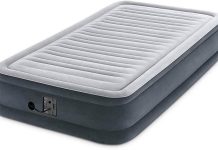Have you ever found yourself wondering how to repair an air mattress valve? Well, look no further because we’ve got your answer! Dealing with a leaky valve on your air mattress can be frustrating, especially when you need a good night’s sleep.
In this article, we’ll take you through the step-by-step process of repairing an air mattress valve so you can rest easy knowing your mattress is in top-notch condition. Say goodbye to sleepless nights and hello to a comfortable and fully functional air mattress!
Review contents
Inspect the Valve
Before attempting to repair an air mattress valve, it is essential to inspect it for any visible damage thoroughly. Examine the valve closely to check for cracks, tears, or any signs of wear and tear. Please pay special attention to the seal around the valve to ensure it is intact. If you notice any visible damage, note it, as it will guide you in determining the appropriate repair method.
Another essential aspect to inspect is whether there are any leaks present. To do this, inflate the air mattress to its maximum capacity and listen for any hissing sounds. If you notice any leaks, try to locate the source by running your hand along the mattress surface, feeling for any air escaping. If the leak is around the valve area, it indicates a valve problem that needs to be addressed.
To further confirm the presence of leaks, you can also perform a simple test using a soapy water solution. Mix water and a small amount of mild liquid soap in a spray bottle and thoroughly spray the valve area with the solution. Inspect the area for any bubbles forming, indicating escaping air from the valve.
Identify the Type of Valve
Air mattresses come with different valves, and it is essential to identify the specific valve type to determine the appropriate repair method. Here are the most common types of valves found in air mattresses:
Pinch Valve
The pinch valve is characterized by a small tube with a soft plastic end that can be pinched to open or close the valve. This type of valve is often found in older air mattresses or cheaper models. Repairing a pinch valve is relatively straightforward and can be done with simple steps.
Twist Valve
As the name suggests, Twist valves have a cylindrical shape that can be twisted to open and close. These valves are commonly found in mid-range air mattresses and are known for their durability. Repairing a twist valve requires a slightly different approach than other valve types.
Push-Pull Valve
Push-pull valves are identifiable by their small plunger-like mechanism that can be pushed or pulled to open or close the valve. They are often found in higher-end air mattresses, providing a secure and airtight seal. Repairing a push-pull valve involves specific steps to ensure the valve functions correctly.
Screw Valve
Screw valves have a threaded shaft that can be screwed in or out to control the airflow. They are popular in camping air mattresses and offer a reliable seal. Repairing a screw valve requires a careful approach to avoid causing further damage.
Boston Valve
Boston valves have two parts – an outer cap and an inner pin. The inner pin can be pulled out to allow air to flow and pushed in to close the valve. This type of valve is commonly found in inflatable kayaks and other water-based products. Repairing a Boston valve involves a slightly more complex process than other valve types.
Repairing Pinch Valve
If you have identified that your air mattress has a pinch valve and requires repair, follow these steps:
Deflate the Mattress
Begin by deflating the air mattress completely. This will make it easier to work on the valve without unnecessary pressure.
Locate the Pinch Valve
Inspect the valve area and locate the pinch valve. It is typically a tiny tube with a soft plastic end that can be pinched.
Replace the Valve
To repair a pinch valve, you will need to replace it with a new one. Pinch valves are not designed to be repaired, so the best solution is to purchase a replacement valve from a retailer or contact the mattress manufacturer for a replacement part. Once you have obtained the new valve, carefully remove the old one by pinching it and gently pulling it out. Please insert the new valve into the opening and ensure it is securely in place.
Repairing Twist Valve
If your air mattress is equipped with a twist valve and it needs repair, follow these steps:
Deflate the Mattress
Start by fully deflating the air mattress to create a safe working environment.
Unscrew the Valve Cap
Inspect the valve area and locate the cylindrical twist valve. You will need to unscrew the valve cap to repair the twist valve. Hold the valve securely with one hand and use the other hand to twist the cap counterclockwise until it is fully unscrewed gently.
Replace the Valve
To repair a twist valve, you will need to replace it with a new one. Twist valves are not designed to be repaired, so purchasing a replacement valve suitable for your specific air mattress model is necessary. Once you have the replacement valve, align it with the opening in the mattress and gently screw the valve cap back on by turning it clockwise until it is tight and secure.
Repairing Push-Pull Valve
If your air mattress is equipped with a push-pull valve that requires repair, follow these steps:
Deflate the Mattress
Ensure the air mattress is completely deflated before attempting any repairs.
Remove the Valve Cap
Inspect the valve area and locate the push-pull valve. To repair this type of valve, you must remove the cap by gently pulling it straight out.
Replace or Repair the Valve
Sometimes, a push-pull valve can be repaired by cleaning or replacing the seal inside the valve. Refer to the manufacturer’s instructions or contact the manufacturer directly to check if replacement seals are available for your valve model. Carefully remove the old seal and replace it with a new one if applicable. If a replacement seal is not available, it may be necessary to replace the entire valve assembly. Follow the manufacturer’s instructions to install the new valve assembly securely.
Repairing Screw Valve
If your air mattress is equipped with a screw valve that needs repair, follow these steps:
Deflate the Mattress
Begin by deflating the air mattress ultimately to make the repair process more accessible.
Unscrew the Valve
Inspect the valve area and locate the screw valve. To repair this type of valve, you must unscrew it by turning it counterclockwise. Use a gentle but firm grip to avoid damaging the valve threads.
Replace the Valve
Repairing a screw valve generally involves replacing the entire valve assembly. Contact the manufacturer or retailer for a replacement valve suitable for your air mattress model. Carefully insert the new valve into the opening and securely screw it in by turning it clockwise until it is tight and snug.
Repairing Boston Valve
If your air mattress is equipped with a Boston valve and it requires repair, follow these steps:
Deflate the Mattress
To ensure safety during the repair process, completely deflate the air mattress.
Remove the Cap and Pin
Locate the Boston valve on your air mattress. You must remove the outer cap and inner pin to access the valve for repair. Unscrew the outer cap by turning it counterclockwise and set it aside. Gently pull the inner pin straight out to remove it from the valve.
Replace the Valve
Repairing a Boston valve involves replacing the entire valve assembly. Contact the air mattress manufacturer or retailer for a suitable replacement valve. Please insert the new valve assembly into the opening and push it in until it is firmly and securely in place. Screw the outer cap back on by turning it clockwise until it is tight and properly sealed.
Using a Repair Kit
If the valve repair requires more than a replacement part, you may need a repair kit specifically designed for air mattresses. Here’s how to use a standard repair kit:
Purchase a Repair Kit
Visit a sports goods store or browse online to find an air mattress repair kit. These kits generally include patches, adhesives, and other necessary tools for repairing various types of damage to the air mattress, including valve repair.
Follow the Instructions
Carefully read and follow the instructions provided with the repair kit. The instructions will outline the specific steps required to repair the valve using the materials provided in the kit.
Apply the Patch or Adhesive
Depending on the instructions in the repair kit, you may need to apply a patch or adhesive to the damaged area around the valve. Follow the instructions precisely, applying the patch or adhesive correctly to create a secure and airtight seal.
Temporary Fixes
While waiting to purchase a repair kit or replacement valve, there are temporary fixes that can help maintain the functionality of the air mattress. Remember that these fixes are not permanent solutions and may not provide a completely airtight seal.
Use Duct Tape
Duct tape can be a quick, temporary fix for small valve leaks. Cut a small piece of duct tape and firmly apply it over the leak or damaged area around the valve. Press down firmly to ensure it adheres properly. While this temporary fix may hold up for a short period, it is essential to remember that duct tape is not a long-term solution and may need to be reapplied as necessary.
Apply Nail Polish
Another temporary solution for small leaks is to apply clear nail polish around the damaged valve area. Ensure the valve is completely dry before applying the nail polish. Brush a layer of clear nail polish onto the damaged section and allow it to dry thoroughly. The nail polish will create a temporary seal that can help reduce air leakage. Remember that this temporary fix may not provide a long-lasting solution.
Utilize a Hot Glue Gun
If you have access to a hot glue gun, it can be used as a temporary fix for small leaks or cracks around the valve. Ensure the valve area is clean and dry before applying hot glue. Apply a small amount of hot glue directly over the leak or crack, being careful not to spread it too wide. Allow the hot glue to cool and harden before using the air mattress. Remember that this is not a permanent repair, and using a hot glue gun may void any warranty on the air mattress.
Prevention Tips
While knowing how to repair an air mattress valve is essential, preventing future valve problems can prolong the lifespan of your mattress. Here are some tips to help prevent valve damage:
Protect the Mattress
Always use a protective covering such as a mattress pad or fitted sheet to prevent valve damage. This will help shield the mattress from potential punctures or wear and tear, reducing the risk of valve problems.
Avoid Overinflating
Overinflating an air mattress puts excessive pressure on the valve and can lead to damage. Follow the manufacturer’s guidelines for inflation and avoid exceeding the recommended pressure levels. Regularly check the mattress’s firmness to ensure it is within the recommended range.
Be Careful During Use
When using an air mattress, be mindful of avoiding sharp objects or rough surfaces that could potentially cause damage to the valve. Please do not place the mattress near sharp-edged furniture or allow pets or children with sharp toys. Being cautious during use can minimize the risk of valve problems.
In conclusion, repairing an air mattress valve is a manageable task that can save you from the inconvenience of a deflating mattress. By carefully inspecting the valve, identifying the valve type, and following the appropriate repair steps, you can extend the lifespan of your air mattress and enjoy a comfortable night’s sleep for years to come.
Additionally, utilizing temporary fixes and practicing prevention tips can provide immediate relief and minimize the risk of future valve damage. Always refer to the manufacturer’s instructions or consult a professional if you are unsure about repair methods. With a little effort and the right approach, you can confidently repair an air mattress valve and keep your sleep experience uninterrupted.































